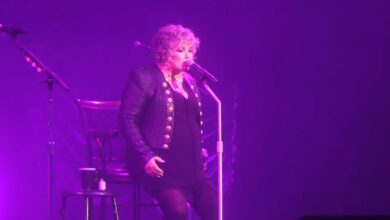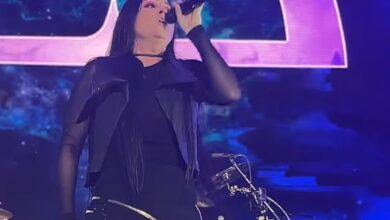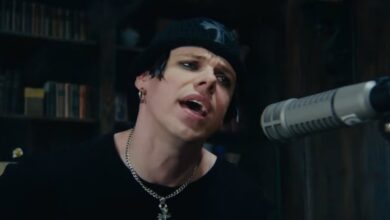Ace Frehley’s Defining Moment: “Deuce” Live at Tiger Stadium, 1996
The heat coming off the infield at Tiger Stadium on June 28, 1996 wasn’t just Michigan summer—it was pent-up expectation finally catching fire. KISS were about to open their first tour with the original lineup since the ’70s, and Detroit, the band’s spiritual launchpad, felt like the only place big enough to hold the blast radius. Outside, scalpers traded tickets like treasure maps; inside, ushers posed for photos with three generations of face paint. This wasn’t a concert so much as a civic event, the kickoff to a reunion run that would dominate the year.
The scale of the comeback had been telegraphed months earlier with a flair only KISS would dare: a press conference aboard the USS Intrepid, Conan O’Brien doing the honors, cameras stacked three deep, and four giants in classic makeup soaking in the flashbulbs. It was half announcement, half declaration of intent—KISS were not merely returning; they were re-establishing sovereignty over stadium rock. Detroit sold nearly 40,000 tickets in a blink, and the message was unmistakable: the circus was back in town, and the tent was enormous.
When the house went to black and the logo flared, you could feel the old rituals snapping back into muscle memory—chants swelling, lighters rippling (this was still the lighter era), and then the ignition: “Deuce.” For lifers, it’s the foundational track, the one that turns a show into a ceremony. The opening crunch rolled through the bowl like a steel wheel, and 39,867 people were instantly on the same downbeat. Even from the cheap seats, you could see the choreography reconnect: Paul pacing the lip, Gene surveying the horizon, Peter hammering the backline—and Ace, already arrowing toward the spotlight.
What makes “Deuce” the ideal reunion opener is its architecture. It’s compact but cinematic, a perfect chassis for KISS’s brand of machined swagger. The verses are street-tough and economical; the breaks are tailor-made for side-by-side poses and synchronized steps; and at the center is a lead-guitar lane broad enough to show character. On this night the lane belonged to Ace Frehley, whose tone came on like polished chrome—a bright top, a molten core, and sustain that felt like it had its own weather system. Every little scooped bend drew a fresh roar, the kind of feedback loop only true stars command.
By the first turnaround, the crowd was clapping on two and four like a single pair of hands. Tiger Stadium has a way of bottling sound—those old bones act like sympathetic wood—and the band exploited it with veteran precision. Pyro shot in time with the snare, the risers hissed, and camera booms skimmed the player sightlines for a future broadcast. This reunion wasn’t nostalgic cosplay; it was an object lesson in stagecraft. Even the pauses felt engineered, calibrated to let the cheers crest before the next punch landed.
Then Ace took the corner and floored it. His “Deuce” break is never about speed; it’s about lift, the way a phrase can pull you upward and then hang you over the crowd before dropping you back on the one. He shaped notes like neon tubing, letting the first few glow before tracing the full sign. There’s that signature vibrato—wider than most players dare, yet somehow elegant—and a sly rhythmic push that makes perfectly simple lines feel dangerous. If you needed one clip to explain why guitarists trace their lineage to the Spaceman, this was it.
Set-list scholars would later chart the entire evening, but in the moment, “Deuce” felt like the thesis statement for what followed—“King of the Night Time World,” “Do You Love Me,” “Calling Dr. Love,” “Cold Gin,” and a blitz of classics stacked with no ballast. The pacing was ruthless: anthem, chant, detonation, repeat. The band knew exactly when to show teeth and when to flash the grin. You don’t rack up the year’s top-grossing tour by accident; you do it by sequencing a night that never gives the audience time to remember to check their watch.
Backstage mythology would later paint the reunion as delicate—egos, history, the usual flammable materials—but out front it read as seamless. The choreography of the famous “Deuce” strut—those side-by-side steps that ricochet through KISS videos—landed with the assurance of a signature. The lenses loved it. You could practically hear directors calling shots: wide for the walk, tight for the pick hand, flare cut to the crowd. In an era when rock spectacle was recalibrating for modern arenas, this was the old religion practiced with new cameras.
What distinguished Tiger Stadium wasn’t just scale, it was context. Detroit as opening salvo mattered. This is the city that wrote “Rock City” into KISS scripture, and on this night the congregation showed up in full regalia: parents in vintage tour tees, kids getting their first lesson in volume, and a whole middle generation that had waited half its life to see the original four as they remembered them. When Ace tilted his head and smiled during the “Deuce” coda, you could feel 20 years melt right off the timeline.
There’s a moment—blink and you miss it—when the front line locks eyes just before the last hit. It’s not sentimentality; it’s recognition. Bands that have done the miles together communicate in glances, and the message was clear: we’ve got this. The final chord landed like a hydraulic press, the flames chased it skyward, and the crowd exhaled in one of those roars that feels physical, like weather. If you could bottle that sound, you’d have an instant understanding of why KISS made arenas their natural habitat.
From there the night widened into a panorama—“Love Gun,” “Shout It Out Loud,” “Black Diamond,” and, of course, the confetti-cyclone of “Rock and Roll All Nite.” But the conversation at the beer lines, the talk on the steps during breathers, kept looping back to that first punch: “Deuce.” People imitated Ace’s hand motions while balancing nachos, debated which arrangement year he was channeling, tried to explain to first-timers why those few minutes meant so much. The consensus wasn’t complicated: this is the band, this is the sound, and this is why we came.
Tour accounts would later confirm what the eyes and ears already knew: the reunion was a juggernaut, a year-long run that proved demand hadn’t just survived; it had grown teeth. Nearly 40,000 in Detroit, multiple sold-out stands in New York and Los Angeles, and a box-office crown for 1996—statistics that read like bragging until you remembered the roar you’d heard on that first downbeat. The numbers were a paper trail for something visceral.
And then there’s the space between then and now—the part that makes revisiting Tiger Stadium both joyous and heavy. In October 2025, news broke that Ace Frehley had died at 74, the first of the original four to pass. Overnight, clips of “Deuce” from that opening night flooded timelines again, shared not as curios but as keepsakes. You could feel the collective recalibration: these weren’t just exciting minutes at the start of a big show; they were a portrait of a player at full command of his gifts.
Obituaries traced his arc—the Bronx kid who found a persona, the near-fatal onstage shock that birthed “Shock Me,” the exits and returns, the solo successes, and the unshakeable influence on generations of guitarists who learned that attitude and melody aren’t opposites but co-pilots. Watching “Deuce” with that story in mind is like discovering new layers in a familiar painting; you notice the patience in his phrasing, the humor tucked into a run, the way he times a grin to a pyrotechnic bloom. The Spaceman nickname feels less like a gimmick and more like a job description.
If you want to understand why so many cite that night as Ace “in his truest form,” listen to the crowd during the breaks. The cheers aren’t polite—they’re possessive. It’s the sound of people hearing their guitarist reclaim their band’s center of gravity. Reunion tours can be museum pieces; this one wasn’t. Tiger Stadium was an upgrade, a reboot, a reminder that KISS didn’t just survive the decades—they refined a very specific electricity, and “Deuce” is the outlet that never shorts.
Some memories are best left hazy; this isn’t one of them. The set lists are archived, the attendance logged, the shaky camcorder footage stabilized for modern eyes. But the reason the performance still rattles your ribcage has nothing to do with documentation. It’s because a great opener tells the truth about a band, and “Deuce” told all of them: the punch, the pose, the humor, the unashamed volume, and the sense that a stadium can be turned into a single, shared heartbeat if the right hands are on the controls.
So if you’re cueing up that clip tonight—face paint optional—pay attention to the first time Ace leans into the light. The camera flares, the crowd swells, and for a few seconds time becomes a loop: 1975 meets 1996 meets now. The chord rings, the steps align, and the Spaceman draws a line straight through the middle of a ballpark and out into the dark. Detroit roars back, as it always does. And somewhere, in the echo, you can still hear the promise that reunion nights make when they get everything right: this isn’t the past. This is forever.





